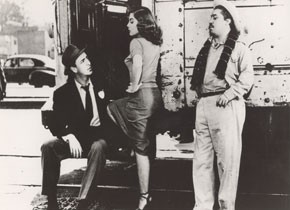February 21 to March 6, 2008
In cooperation with the Berlin Film Festival and the Deutsche Kinemathek, the Austrian Film Museum shows the Complete Works of Luis Buñuel (1900-1983) from February 21 to April 6. The Spanish director, whose works were almost entirely created in exile, was one of the major figures in 20th Century culture. His subversive and sarcastic oeuvre, constantly shadowed by state and church censorship attempts, spans the golden age of Surrealism and the worldwide success of European art films in the 1960s and 70s, when Buñuel was able to work with stars like Catherine Deneuve, Jeanne Moreau or Michel Piccoli. Many of these later films became classics despite, or perhaps because of, their caustic anti-bourgeois stance: The Exterminating Angel, Belle de Jour and Viridiana, Diary of a Chambermaid, Tristana and The Discreet Charm of the Bourgeoisie.
Buñuel's film work started out with an eye being cut up (by him) and ends with the world being blown up. Between the exciting beginning of Un chien andalou (1929) and the calm valediction This Obscure Object of Desire (1977) lies one of the most fascinating film careers of all time. The "Andalusian dog", which Buñuel and Salvador Dail had assembled according to the logic of dreams, was immediately followed by two more shockers: L'Age d'or (1930, the climax of French avant-garde cinema) and Las Hurdes (1932, a provocative film essay about the eponymous region of famine in the Southwest of Spain). After these works, Buñuel was unable to shoot any film for the next 15 years. The Republicans' defeat in the Spanish Civil War drove him into exile; first to Paris, then New York, and finally Mexico, where he experienced his resurrection as a film director.
The Mexican films from 1947 to 1962 make up the true core of Buñuel's oeuvre. Between such classics as his drama about slum children Los Olvidados (1950), which expands the tradition of Neorealism by adding elements of the fantastic and mysterious, and seemingly impersonal works on commission in the midst of the local commercial cinema, he arrived at a perfect expression of Surrealism. Its effect arises precisely from the off-handedness of the form: without realism, the whole "sur" prefix isn't worth a dime. This simplicity of Buñuel's style was perfectly complemented by the demands of the Mexican film industry: whether a charming road movie (Subida al cielo) or a drama about a priest (Nazarin), whether an idiosyncratic literature adaptation (Robinson Crusoe) or deep-black comedies about male pathology (Él and Ensayo de un crimen) – Buñuel's philosophical interests and casual blasphemies, his irrational digressions and his penchant for depraved details are always unmistakable. They also blend into the requirements of the respective genres in a manner both irritating and ironic.
The "natural" subversiveness of these works was recognized only much later as being the quintessence of Buñuel. Critics of the time, however, were only prepared to fully accept him again when he returned to Europe, after the scandal surrounding his Spanish "comeback" Viridiana (1961, winner in Cannes, and banned in Spain) and the global success of the following films. A fully accredited Old Master, Buñuel now supplied a series of surreal party games with artistic value to that same delighted bourgeoisie which he so loved to mock. As his brilliant autobiography "My Last Sigh" clearly shows, his tendency towards the fully savoured paradox is inseparable from both Buñuel's work and his person: an atheist with a predilection for religious debates; an anarchist who considered dictatorship the best, indeed "only possible" form of government; a "dyed-in-the-wool-bourgeois Communist". A genius of the cinema.


